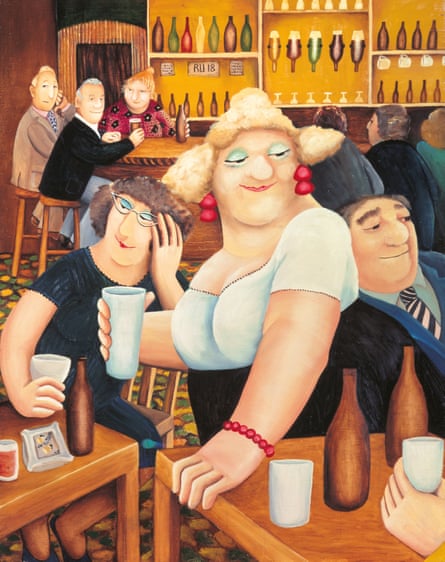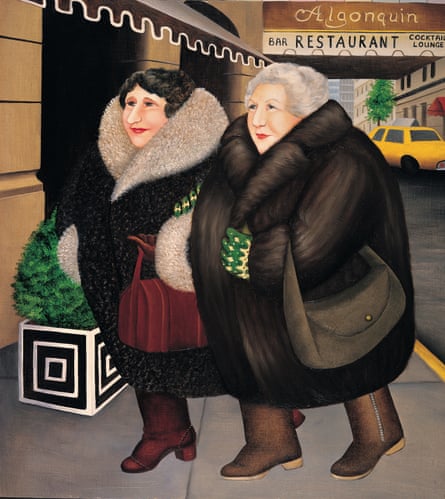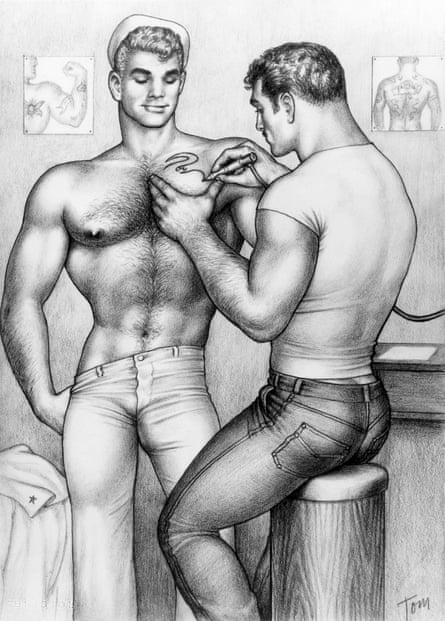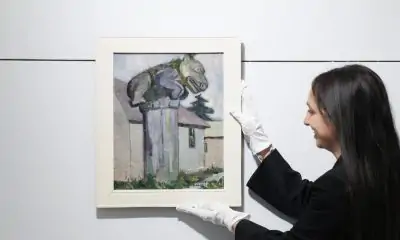Art
Bottoms up! The joyfully lewd art of Beryl Cook and Tom of Finland
The ways in which artists become accepted by the art world are many and complicated. Take the reputations of Beryl Cook (1926-2008) and Touko Laaksonen, better known as Tom of Finland (1920-1991). Both spent most of their careers having their work either ignored or actively disdained by the establishment: Cook cast as purveyor of saucy seaside postcards in oil, Tom as homoerotic cartoonist. Then, later in life and having already attracted significant followings outside the gallery and museum systems, they were eventually granted some sort of official approval.
“But they have far more in common than just career trajectories,” says Joe Scotland, director of Studio Voltaire in London and co-curator of a new joint exhibition. “In formal terms they both articulate the human figure in very distinctive and hyper-realised ways. And from that emerges a wonderful sense of pleasure and fun and desire that is free of any sense of shame. You can also explore ideas around gender, class, politics, body image and much more in their work. And then, of course, there are simply joyous celebrations of some amazing bums.”
Cook came to public attention in the late 1970s when she was already into her 50s and running a guest house in Plymouth. Her brightly hued depictions of middle-aged women – usually dubbed “larger than life” – enjoying themselves whether in bars or on bowling greens were described by Victoria Wood as “Rubens with jokes”.
“Yet the notion of her work as naive persisted right up to her many obituaries,” says Studio Voltaire co-curator Nicola Wright. “There are also clear art-historical links in that she was much influenced by Stanley Spencer and then Edward Burra. And her paintings are important and empowering representations of working-class women’s lives, delivered in very direct and very humorous ways. She was also a queer ally – while she was married with kids she was surrounded by close friends who were gay and these depictions run throughout her practice.”
Tom of Finland – the name adopted to hide his identity – was in 1957 an advertising illustrator and part-time contributor to the American magazine Physique Pictorial, which specialised in well-muscled young men wrestling or doing whatever else would evade the censors of the time. In due course, his art became his primary activity; he began to distribute it by mail order and it became so successful he had to set up a company to protect his copyright as it was beginning to be pirated.
“For a long time it was somewhat dismissed as only of interest in terms of gay erotica,” says Scotland. “But people are increasingly examining the more conceptual side. It is very much about building imaginary scenarios and imaginary men. When he was growing up, gay men were habitually depicted as effeminate and weak and Tom explicitly wanted to counter this by representing gay men as masculine, strong, happy and celebrated.”
The result was hugely influential. The gay communities that emerged in the 60s and 70 were more taking their look – macho-inflected uniforms, leather, bikers, sailors, muscles etc – from him than he was representing them. “Tom had sort of invented a blueprint and you can see it everywhere from Jean Paul Gaultier to Freddie Mercury or even the Village People.”
Over the last decade or so, the Finnish state has officially embraced Tom, even issuing a set of commemorative stamps featuring his images. Cook received an OBE and her paintings are held in British museums. But there is still work to be done, says Scotland: “It’s interesting to speak to younger or international artists who aren’t familiar with all the baggage about her being populist and self-taught and so on. They don’t see her as so easy to dismiss and I think they are right. I hope this show leads to further re-evaluation of Tom and especially of Beryl’s work, and if the Tate were to acquire some of her work then I think we’d have done our job.”
In the flesh: works by Beryl and Tom

Beryl Cook – The Lockyer Tavern, 1976
This image of the back bar in a Plymouth pub launched Cook’s career. The bar was predominantly used by gay men but was also a space where straight women and sex workers were also welcome and felt safe. It is an early example of Cook documenting people and places in her home town that had been previously hidden.
Beryl Cook – Lady of Marseille, c.1990 (main image)
Cook visited Marseille, where Edward Burra had painted the louche scene around the dockside cafes, and saw this woman and her little dogs. While the work is comedic and exaggerated, it has the striking ring of truth.

Beryl Cook – Bar and Barbara, 1986
Barbara Ker-Seymer had been a friend of painter Edward Burra, who recognised Beryl Cook as a kindred spirit. Cook painted Barbara on an imaginary and glamorous trip to New York saying that, while Cook was a mother who ran a guesthouse in Plymouth, through her work she lived a far racier life.

Tom of Finland – On the Bike, 1973
An archetypal Tom of Finland image of hyper-macho bikers and leathermen. His early commissions explicitly precluded him from including Black men, but as he gained autonomy over his career Tom often chose to represent Black figures and Black desire.

Tom of Finland – Untitled: From the Athletic Model Guild ‘The Tattooed Sailor’ series, 1961
An early work that illustrates one of Tom’s key tropes: the depiction of sailors with a sense of tenderness and humour that would have such an influence over the likes of Jean Paul Gaultier.

Tom of Finland – Untitled Portrait of Durk Dehner, 1984
Durk Dehner was a friend of Tom and is still involved in the Tom of Finland Foundation, which initially protected Tom’s work from piracy and was later instrumental in helping it transition from its dismissal as erotica to acceptance within a contemporary art context.
Beryl Cook/Tom of Finland is at Studio Voltaire, London, 15 May to 25 August.

Art
Michael Nicoll Yahgulanaas on mixing Haida art with Japanese manga – CBC.ca
[unable to retrieve full-text content]
Michael Nicoll Yahgulanaas on mixing Haida art with Japanese manga CBC.ca

Source link
Art
Duct-taped banana artwork auctioned for $6.2m in New York – BBC.com
[unable to retrieve full-text content]
- Duct-taped banana artwork auctioned for $6.2m in New York BBC.com
- A duct-taped banana sells for $6.2 million at an art auction NPR
- Is this banana duct-taped to a wall really worth $6.2 million US? Somebody thought so CBC.ca
Art
40 Random Bits of Trivia About Artists and the Artsy Art That They Articulate – Cracked.com
[unable to retrieve full-text content]
40 Random Bits of Trivia About Artists and the Artsy Art That They Articulate Cracked.com

Source link
-

 News18 hours ago
News18 hours agoEstate sale Emily Carr painting bought for US$50 nets C$290,000 at Toronto auction
-

 News18 hours ago
News18 hours agoClass action lawsuit on AI-related discrimination reaches final settlement
-

 News18 hours ago
News18 hours agoCanada’s Hadwin enters RSM Classic to try new swing before end of PGA Tour season
-

 News19 hours ago
News19 hours agoAll premiers aligned on push for Canada to have bilateral trade deal with U.S.: Ford
-

 News18 hours ago
News18 hours agoTrump nominates former congressman Pete Hoekstra as ambassador to Canada
-

 News18 hours ago
News18 hours agoFormer PM Stephen Harper appointed to oversee Alberta’s $160B AIMCo fund manager
-

 News18 hours ago
News18 hours agoEx-student pleads guilty to fatally shooting 3 University of Virginia football players in 2022
-

 News18 hours ago
News18 hours agoComcast to spin off cable networks that were once the entertainment giant’s star performers



















